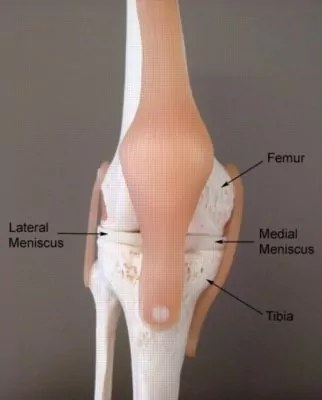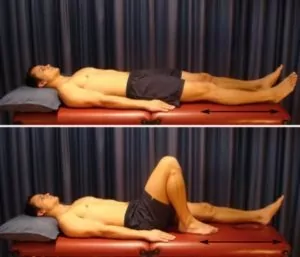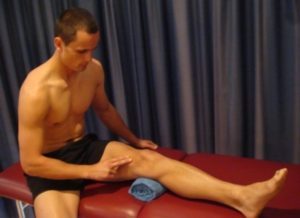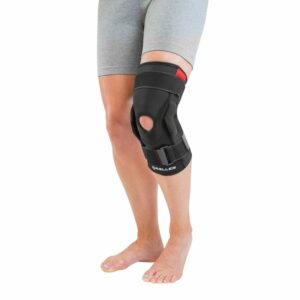Medial Meniscus Tear
Updated:
(Also known as a Medial Meniscal Tear, Torn Medial Meniscus, Medial Cartilage Tear, Medial Meniscal Dysfunction, Bucket Handle Tear of the Medial Meniscus, Torn Meniscus)
What is a medial meniscus tear?
A medial meniscus tear is an injury characterized by tearing of cartilage tissue located at the inner aspect of the knee and typically causes pain in this region.
The knee joint comprises of the union of two bones: the long bone of the thigh (femur) and the shin bone (tibia) (figure 1). Between the bone ends are 2 round discs made of cartilage called the medial (inner) and lateral (outer) meniscus (figure 1).

Each meniscus acts as a shock absorber cushioning the impact of the femur on the tibia during weight-bearing activity. Normally the surface of the meniscus is very smooth allowing easy movement of the femur on the tibia. Occasionally, due to excessive weight bearing or twisting forces, the meniscus can be torn or damaged so that the surface is no longer smooth. When this occurs to the medial meniscus, it is known as a medial meniscus tear.
Injuries to the medial meniscus are more common than lateral meniscus injuries. Occasionally a medial meniscus tear may occur in combination with injuries to other structures of the knee, such as the cruciate ligaments, the collateral ligaments, the patello-femoral joint or the lateral meniscus.
Causes of a medial meniscus tear
Medial meniscus tears often occur traumatically due to excessive weight bearing and twisting forces. This typically occurs in sports that require sudden changes of direction and twisting movements (sometimes in combination with excessive straightening or bending of the knee). These sports may include football, soccer, basketball, netball and snow skiing. Medial meniscal tears frequently take place when the foot is fixed on the ground and a twisting force is applied to the knee (e.g. when another player’s body falls across the leg, or when a player is tackled) or following a fall, a forceful jump or landing. They may also occur traumatically during heavy lifting (particularly with deep squatting or lunging combined with twisting movements).
A torn meniscus may also occur over time through gradual wear and tear associated with overuse. This typically occurs in association with repetitive or prolonged weight bearing or twisting forces that are beyond what the meniscus can withstand (e.g. excessive distance walking or running, particularly up or down hills or on uneven surfaces). Overuse meniscal injuries may also be associated with degenerative changes to the knee joint. In older patients where degenerative changes are present, injury to the medial meniscus may occur with a relatively trivial movement.
Signs and symptoms of a medial meniscus tear
Patients with a medial meniscal tear often experience a sudden, sharp pain at the inner aspect, front or back of the knee at the time of injury. Some patients may also report that they heard an audible sound at the time of injury or experienced a tearing sensation. There is usually pain with repetitive or prolonged weight bearing activity and twisting movements of the knee. Patients may also experience pain when climbing stairs, attempting to kneel or when squatting or lunging. Swelling is often present and may occur a few hours after injury or, more commonly, in the following days. Tenderness may also be experienced on firmly touching the knee joint at the inner aspect of the knee. The knee may also feel weak or unstable and may click, lock or give way during certain movements.
In minor cases of medial meniscus tears there may be little or no immediate symptoms. In these cases, symptoms may develop gradually over the coming days, typically with an increase in weight bearing or twisting activity. In more severe cases there may be severe pain and significant restriction in knee range of movement. Intermittent locking, clicking sensations, and episodes of giving way or collapsing may be present. The patient may also walk with a limp or, be unable to weight bear due to pain.
Diagnosis of a medial meniscus tear
A thorough subjective and objective examination from a physiotherapist is usually sufficient to diagnose a medial meniscus tear. Investigations such as X-ray and MRI are sometimes used to confirm diagnosis and exclude the presence of other injuries in the knee. In rare cases, where an MRI has proven inconclusive, an investigative arthroscope may be performed to assist diagnosis.
Treatment for a medial meniscus tear

Members Only ContentBecome a PhysioAdvisor Member to gain full access to this exclusive content. For more details see Become a Member. Already a member? Login Now
Surgery for a medial meniscus tear
Despite appropriate physiotherapy management, a small percentage of minor meniscal tears fail to improve and may require surgery for an optimal outcome. The majority of large meniscal tears also require surgery. This is particularly true in those cases where the knee is ‘locked’. Surgery for medial meniscus tears is minimally invasive. The procedure is called a knee arthroscopy and typically involves a surgeon cutting away the torn part of the cartilage via 2 small incisions so that the meniscal surface is smooth once again. The aim of surgery is to preserve as much of the meniscus as possible in attempt to maintain shock absorption capacity of the knee and to prevent future degeneration. The treating physiotherapist and doctor will refer to a specialist if surgery is indicated. Physiotherapy and rehabilitation is then required following surgery to ensure an optimal outcome and enable a safe return to sport or activity. This should ideally commence before surgery to hasten recovery.
Prognosis of a medial meniscus tear
Those patients with minor medial meniscus tears that are managed conservatively can usually expect to return to sport or activity in approximately 2 – 4 weeks. For moderate tears that are managed conservatively return to sport or activity may take 4 – 6 weeks or longer.
Minor medial meniscus tears that are managed surgically can sometimes return to sport or activity within 4 – 6 weeks, although most surgical repairs (especially when the meniscus tear is moderate to severe) will usually require a rehabilitation period of 6 – 8 weeks or longer. If there is damage to other structures in the knee, such as the anterior cruciate ligament, rehabilitation may require an extended period. It is important that medial meniscus injuries are managed appropriately, as inappropriate treatment may lead to the development of early knee osteoarthritis.
Contributing factors to the development of a medial meniscus tear
There are several factors which can predispose patients to developing a torn meniscus. These need to be assessed and corrected with direction from a physiotherapist. Some of these factors include:
- muscle weakness (particularly of the quadriceps, hamstrings or gluteals)
- muscle tightness (particularly of the quadriceps, hamstrings or calf)
- inappropriate or excessive training or activity
- insufficient recovery periods from training or activity
- inadequate warm up
- joint stiffness (especially the knee, hip or ankle)
- poor biomechanics
- inadequate rehabilitation following a previous knee injury
- decreased fitness
- fatigue
- poor pelvic and core stability
- poor balance
Physiotherapy for a medial meniscus tear
Physiotherapy treatment is vital to hasten the healing process and ensure an optimal outcome in all patients with a torn medial meniscus regardless of whether they have surgery. Physiotherapy treatment may comprise:
- soft tissue massage
- electrotherapy
- taping or bracing to support the knee
- the use of crutches
- mobilization
- dry needling
- hydrotherapy
- ice or heat treatment
- progressive exercises to improve flexibility, balance and strength (especially of the VMO muscle)
- activity modification advice
- education
- biomechanical correction
- anti-inflammatory advice
- weight loss advice where appropriate
- the use of Real-Time Ultrasound to assess and retrain the VMO muscle
- a gradual return to activity program
For those patients who are undergoing surgery to repair the medial meniscus tear, physiotherapy and rehabilitation should commence prior to surgery. This may include treatment to reduce pain and swelling, electrotherapy, strengthening and range of movement exercises, the use of a compression bandage, and the use of crutches etc. Following surgery, physiotherapy and rehabilitation is essential to assist the healing process and ensure an optimal outcome.
In the final stages of rehabilitation for all medial meniscus tears the physiotherapist can devise an appropriate return to sport or activity plan. Returning to activity too soon or without adequate rehabilitation will often lead to knee swelling and re-injury to the meniscus.
Other intervention for a medial meniscus tear
Despite appropriate physiotherapy management, some patients with medial meniscus tears fail to improve either conservatively or following surgery. When this occurs the treating physiotherapist or doctor can advise on the best course of management. This may include further investigations, pharmaceutical intervention, corticosteroid injection, or further surgery.
Exercises for a medial meniscus tear
The following exercises are commonly prescribed to patients with a medial meniscus tear. You should discuss the suitability of these exercises with your physiotherapist prior to beginning them. Generally, they should be performed 3 times daily and only provided they do not cause or increase symptoms.
Your physiotherapist can advise when it is appropriate to begin the initial exercises and eventually progress to the intermediate and advanced exercises. As a general rule, addition of exercises should take place provided there is no increase in symptoms.
Initial Exercises
Knee Bend to Straighten
Bend and straighten your knee as far as possible and comfortable without increasing your pain (figure 2). Repeat 10 – 20 times provided there is no increase in symptoms.

Static Quadriceps Contraction
Tighten the muscle at the front of your thigh (quadriceps) by pushing your knee down into a towel (figure 3). Put your fingers on your inner quadriceps to feel the muscle tighten during contraction. Hold for 5 seconds and repeat 10 times as hard as possible without increasing your symptoms.

Intermediate Exercises

Members Only ContentBecome a PhysioAdvisor Member to gain full access to this exclusive content. For more details see Become a Member. Already a member? Login Now
Advanced Exercises

Members Only ContentBecome a PhysioAdvisor Member to gain full access to this exclusive content. For more details see Become a Member. Already a member? Login Now
Rehabilitation Guide for a medial meniscal tear

Members Only ContentBecome a PhysioAdvisor Member to gain full access to this exclusive content. For more details see Become a Member. Already a member? Login Now
 Physiotherapy products for a medial meniscus tear
Physiotherapy products for a medial meniscus tear
Some of the most commonly recommended products by physiotherapists to hasten healing and speed recovery in patients with a medial meniscus tear include:
To purchase physiotherapy products for a medial meniscus tear click on one of the above links or visit the PhysioAdvisor Shop.
 Find a Physio for a medial meniscus tear
Find a Physio for a medial meniscus tear
Find a physiotherapist in your local area who can treat a torn meniscus.
 More Information
More Information
- Knee Strengthening Exercises.
- Knee Flexibility Exercises.
- How to use Crutches.
- Ice or Heat.
- Why is my Injury not Improving?
- Knee Arthroscopy.
- Return to Running.
- Return to Sport.
- Knee Injury Diagnosis Guide.
Become a PhysioAdvisor Member

Link to this Page
If you would like to link to this article on your website, simply copy the code below and add it to your page:
<a href="https://physioadvisor.com.au/injuries/knee/medial-meniscus-tear”>Medial Meniscus Tear – PhysioAdvisor.com</a><br/>PhysioAdvisor offers detailed physiotherapy information on a medial meniscus tear or torn meniscus including signs and symptoms, causes, diagnosis, treatment, exercises and physiotherapy products.
Return to the top of Medial Meniscus Tear.











